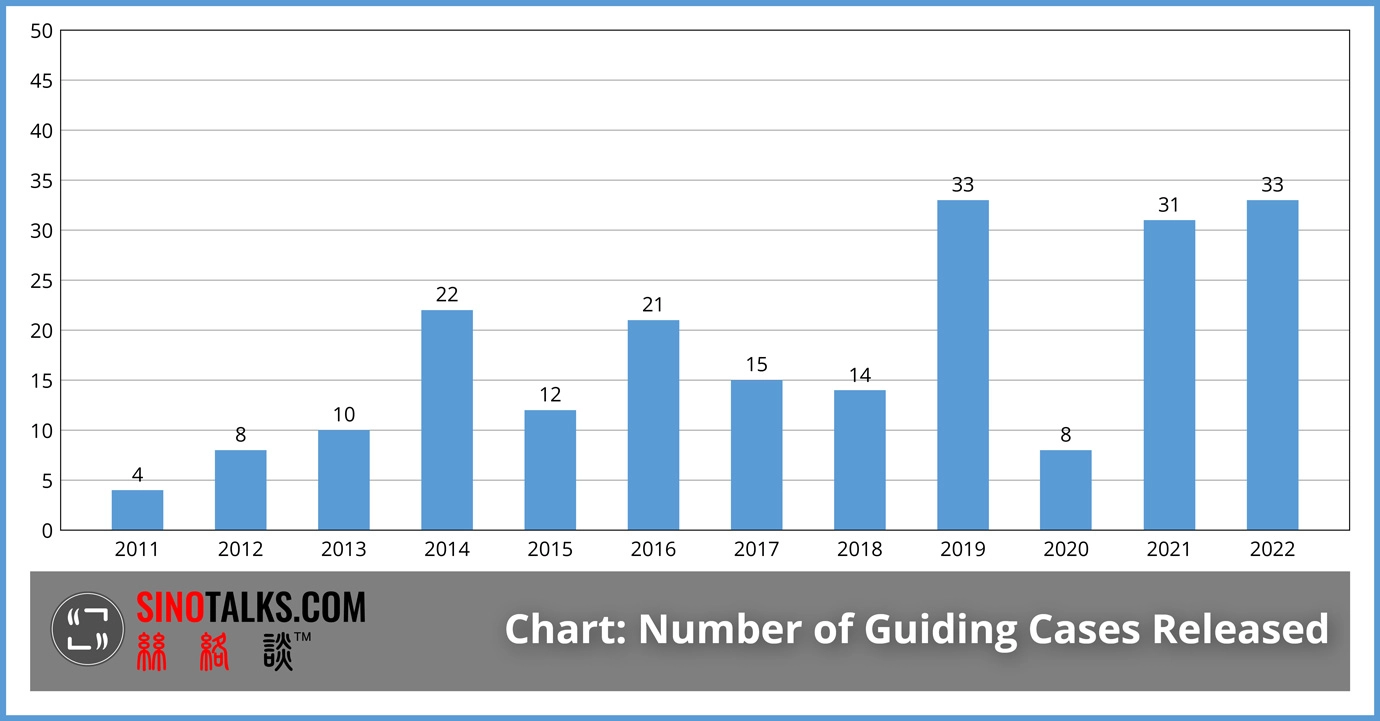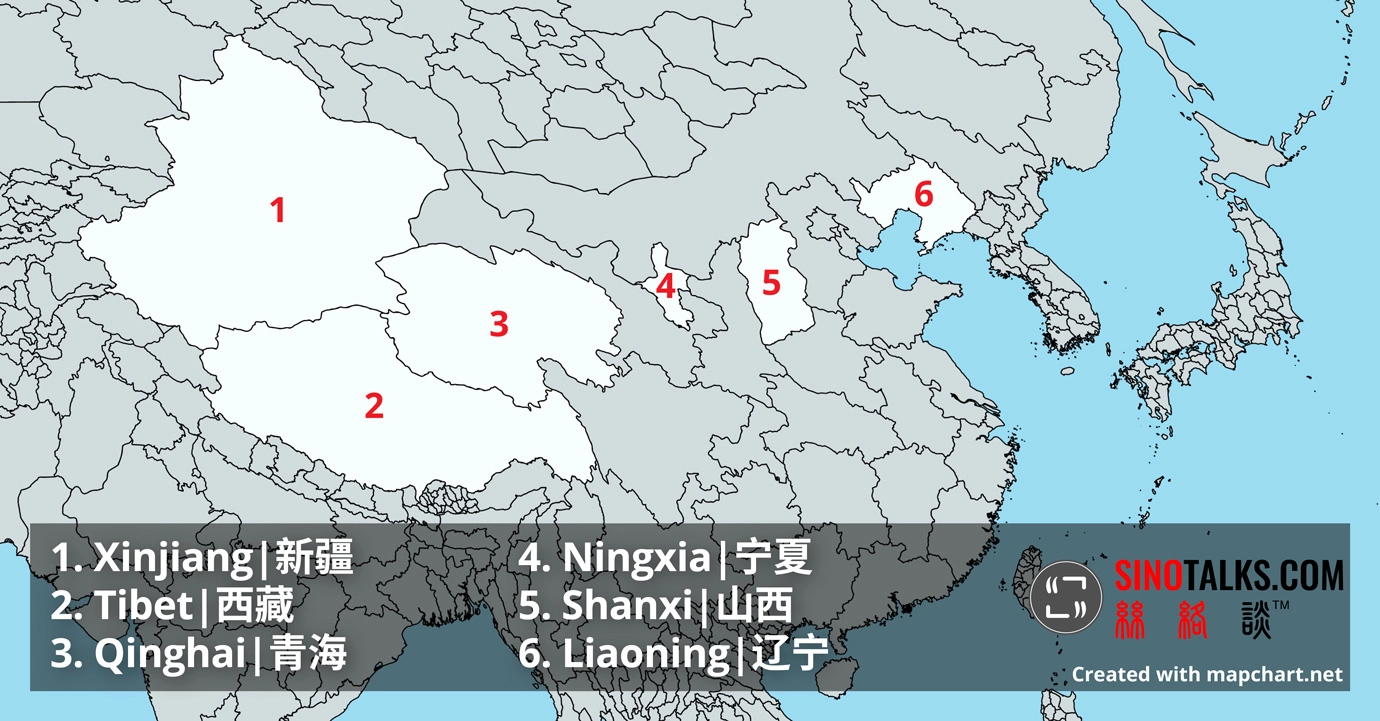Supreme People’s Court of China’s Strong 2022 Ending Gives Optimism for 2023†
Table of Contents
Estimated Reading Time
- 6 min

The Supreme People’s Court’s issuance of 26 new Guiding Cases, China’s de facto binding precedents, during the last few weeks of 2022 brought the total number of these cases issued in the entire year to 33, a record-high number that has only been matched in 2019.
Of all 211 Guiding Cases released thus far by the Supreme People’s Court, nearly half were issued in 2019 and the three years afterwards. A comparison of these cases with the other half released from the preceding eight years (i.e., 2011 to 2018) shows positive developments and, as explained below, gives optimism for 2023.
Return to the Pre-COVID Peak Level

Seeing the need to use cases to ensure judicial consistency and thereby unify the application of law, the Supreme People’s Court began issuing Guiding Cases in late 2011, requesting that judges across the country, including those working at the Supreme People’s Court, cite Guiding Cases when handling subsequent cases similar to Guiding Cases.
Before 2019, the Supreme People’s Court never released more than 30 Guiding Cases per year, with 2014 and 2016 seeing the highest number of cases released, i.e., 22 and 21, respectively (see Chart). Apparently, the experience accumulated over the first eight years allowed the Supreme People’s Court to feel ready for a breakthrough in 2019: a record number of 33 Guiding Cases were issued that year. That breakthrough, however, could not be sustained in 2020 (only eight Guiding Cases were released), likely due in part to the challenge presented by the sudden outbreak of COVID-19 to China’s nationwide selection process of potential Guiding Cases.
Fortunately, the number of Guiding Cases released rose to 31 in 2021 and then 33 in 2022. Such rise is welcome because lawyers and judges in China have often expressed their wish to see more Guiding Cases provide guidance on legal issues. The rise in numbers also gives hopes that the Supreme People’s Court has managed to stabilize the selection process and that the number of Guiding Cases released in 2023 may continue to return to the pre-COVID-19 level seen in 2019.
Three Positive Developments Since 2019
Released during the period from 2019 to 2022, Guiding Case Nos. 107-211 (i.e., 105 Guiding Cases in total) account for 49.8 per cent of all 211 Guiding Cases in existence. A comparison of these cases with Guiding Case Nos. 1-106, which were released from 2011 to 2018, shows three positive developments:
- Number of Guiding Cases Focusing on Enforcement Has Increased Substantially
The 211 Guiding Cases mostly address issues related to civil, criminal, and/or administrative litigation to ensure the quality of judgments rendered in China. While this is important, the value of well-reasoned judgments cannot be realized if they are not enforced effectively or at all. The Chinese judiciary is authorized to make rulings if, for example, legally effective judgments are challenged by parties that are supposed to enforce them.
“Rulings showing how courts apply legal principles to handle enforcement-related challenges are, therefore, significant.”
Rulings showing how courts apply legal principles to handle enforcement-related challenges are, therefore, significant. Seven Guiding Cases released before 2019 primarily cover enforcement issues (i.e., Guiding Case Nos. 34-37, 43, 54, and 71). Since 2019, 14 Guiding Cases of this type (i.e., Guiding Case Nos. 116-126, and 154-156) have been released. For example, Guiding Case No. 125 makes the following principle clear:
Online judicial auctions, which are judicial auctions conducted by people’s courts through Internet auction platforms, are a type of compulsory enforcement measure. People’s courts should apply the provisions of the Civil Procedure Law [instead of another law that regulates commercial auctions] and related judicial interpretations to handle disputes arising from online judicial auctions.
- Supreme People’s Court: A Significant Source of Guiding Cases
The 211 Guiding Cases are essentially summaries prepared by the Supreme People’s Court, based on select well-reasoned judgments/rulings rendered by courts in China, regardless of their seniority in the country’s court system, which consists of four levels of courts: basic courts, intermediate courts, high courts, and the Supreme People’s Court. That said, a large majority (i.e., 178) of the 211 Guiding Cases are based on final judgments/rulings rendered by courts at the intermediate level or above. This likely reflects the fact that judges of these courts, compared with their counterparts at basic-level courts, are usually better trained and, therefore, more able to prepare well-reasoned judgments/rulings.
It is worth noting that 65 of the 211 Guiding Cases are sourced from Supreme People’s Court judgments/rulings. Of these 65 Guiding Cases, 26 were released before 2019, while 39 in 2019 or after. This suggests that the Supreme People’s Court has become more ready to select its own judgments/rulings for reissuance as Guiding Cases—a natural step reflecting the highest court’s role and increasing competence as the final arbiter of adjudication issues in China. In fact, all the 14 Guiding Cases focusing on enforcement released since 2019, as discussed above, are based on Supreme People’s Court rulings.
- Guiding Cases are Sourced from More Provinces
“Five Guiding Cases released from 2019 to 2022 are based on judgments/rulings rendered by courts located in provinces that never yielded any Guiding Cases released before 2019.”
Five Guiding Cases released from 2019 to 2022 are based on judgments/rulings rendered by courts located in provinces that never yielded any Guiding Cases released before 2019. These provinces are Guangxi, Hainan, Jilin, and Yunnan. As a result, the only provinces/provincial-level regions that have not become sources of Guiding Cases are Liaoning, Ningxia, Qinghai, Shanxi, Tibet, and Xinjiang (see Map).

All of the above positive developments are encouraging. What is more encouraging is that a broader range of legal issues have been addressed, with good reasoning, in Guiding Cases released in recent years. They shed real light on the Chinese judiciary’s gradual progress towards its own goal: uniform application of law. These are topics that need in-depth analyses, which the SINOTALKS® team will conduct in 2023.
Do stay tuned. Happy Year of the Rabbit!
† The citation of this article is: Dr. Mei Gechlik, Supreme People’s Court of China’s Strong 2022 Ending Gives Optimism for 2023, SINOTALKS.COM®, In Brief No. 28, Jan. 25, 2023, https://sinotalks.com/inbrief/supreme-court-china-optimism.
The original, English version of this article was edited by Nathan Harpainter. The information and views set out in this article are the responsibility of the author and do not necessarily reflect the work or views of SINOTALKS®.




